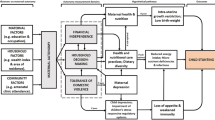Abstract
Objectives
Investigate the relationship between maternal autonomy at multiple levels and the risk of child stunting, underweight, and wasting in India.
Methods
Data were from a 2005–2006 nationally representative, cross-sectional sample of 51,555 children under 5 years from 29 states in India. Multilevel, multivariable, logistic regression analyses were used to estimate the odds of child stunting, underweight, and wasting in relation to maternal autonomy in healthcare, movement, and money at the individual level and community level, while adjusting for several child, maternal, and household factors.
Results
When only adjusting for child age and sex, children in communities with a high proportion of women with autonomy in healthcare, or movement, or money, separately, had a lower risk of being stunted, underweight, or wasted, separately. However, adjusting for other explanatory factors attenuated these relationships and made them statistically insignificant. Individual maternal autonomy in any of the three domains was not associated with any of the outcomes.
Conclusions
The results suggest that caution should be taken when interpreting the direct relevance of maternal autonomy at both individual and community levels to measures of child undernutrition.
Similar content being viewed by others
References
Agarwala R, Lynch SM (2006) Refining the measurement of women’s autonomy: an international application of a multi-dimensional construct. Soc Forces 84(4):2077–2098. doi:10.1353/sof.2006.0079
Alderman H, Lokshin M, Radyakin S (2011) Tall claims: mortality selection and the height of children in India. Econ Hum Biol 9(4):393–406. doi:10.1016/j.ehb.2011.04.007
Arulampalam W, Bhaskar A, Srivastava N (2012) Does greater autonomy among women provide the key to better child nutrition. Economic and Social Research Council, Swindon
Banerjee A, Iyer L, Somanathan R (2005) History, social divisions, and public goods in rural India. J Eur Econ Assoc 3(2–3):639–647. doi:10.1162/jeea.2005.3.2-3.639
Black RE et al (2008) Maternal and child undernutrition: global and regional exposures and health consequences. Lancet 371(9608):243–260. doi:10.1016/S0140-6736(07)61690-0
Bloom SS, Wypij D, Gupta Md (2001) Dimensions of women’s autonomy and the influence on maternal health care utilization in a north Indian city. Demography 38(1):67–78
Corsi DJ, Mejía-Guevara I, Subramanian SV (2015) Risk factors for child chronic undernutrition in India: estimating relative importance, population attributable risk and fractions. Soc Sci Med. doi:10.1016/j.socscimed.2015.11.014
Cunningham K et al (2015a) Women’s empowerment in agriculture and child nutritional status in rural Nepal. Public Health Nutr 18(17):3134–3145. doi:10.1017/S1368980015000683
Cunningham K, Ruel M, Ferguson E, Uauy R (2015b) Women’s empowerment and child nutritional status in South Asia: a synthesis of the literature. Matern Child Nutr 11(1):1–19. doi:10.1111/mcn.12125
Dangour AD et al (2013) Interventions to improve water quality and supply, sanitation and hygiene practices, and their effects on the nutritional status of children. Cochrane Database Syst Rev 8, Art ID CD009382. doi:10.1002/14651858.CD009382.pub2
Desai S, Johnson K (2005) Women’s decisionmaking and child health: familial and social hierarchies. In: Kishor S (ed) A focus on gender. ORC Macro, Calverton, pp 55–68
Dyson T, Moore M (1983) On kinship structure, female autonomy, and demographic behavior in India. Popul Dev Rev 9(1):35–60
Ghuman SJ, Lee HJ, Smith HL (2006) Measurement of women’s autonomy according to women and their husbands: results from five Asian countries. Soc Sci Res 35(1):1–28. doi:10.1016/j.ssresearch.2004.06.001
Hoddinott J et al (2011) The consequences of early childhood growth failure over the life course. Int Food Policy Res Inst 1073. https://core.ac.uk/download/files/153/6314946.pdf. Accessed 1 July 2016
IIPS, ORC-Macro (2007) National Family Health Survey, 2005–2006: India. International Institute for Population Sciences, Mumbai
Imai KS, Annim SK, Kulkarni VS, Gaiha R (2014) Women’s empowerment and prevalence of stunted and underweight children in rural India. World Dev 62:88–105. doi:10.1016/j.worlddev.2014.05.001
Kabeer N (2005) Gender equality and women’s empowerment: a critical analysis of the third millennium development goal. Gend Dev 13(1):13–24
Mahmud S, Shah NM, Becker S (2012) Measurement of women’s empowerment in rural Bangladesh. World Dev 40(3):610–619. doi:10.1016/j.worlddev.2011.08.003
Malhotra A, Schuler SR (2005) Women’s empowerment as a variable in international development. In: Narayan-Parker D (ed) Measuring empowerment: cross-disciplinary perspectives. World Bank Publications, Washington, D.C., pp 71–88
Pongou R, Ezzati M, Salomon J (2006) Household and community socioeconomic and environmental determinants of child nutritional status in Cameroon. BMC Publ Health 6(1):98
Subramanian SV, Ackerson LK, Davey Smith G, John NA (2009) Association of maternal height with child mortality, anthropometric failure, and anemia in India. JAMA 301(16):1691–1701. doi:10.1001/jama.2009.548
Author information
Authors and Affiliations
Corresponding author
Ethics declarations
Ethical approval
All procedures performed in studies involving human participants were in accordance with the ethical standards of the institutional and/or national research committee and with the 1964 Helsinki declaration and its later amendments or comparable ethical standards.
Additional information
R. Rajaram and J. M. Perkins are co-first authors.
Electronic supplementary material
Below is the link to the electronic supplementary material.
Rights and permissions
About this article
Cite this article
Rajaram, R., Perkins, J.M., Joe, W. et al. Individual and community levels of maternal autonomy and child undernutrition in India. Int J Public Health 62, 327–335 (2017). https://doi.org/10.1007/s00038-016-0850-8
Received:
Revised:
Accepted:
Published:
Issue Date:
DOI: https://doi.org/10.1007/s00038-016-0850-8




